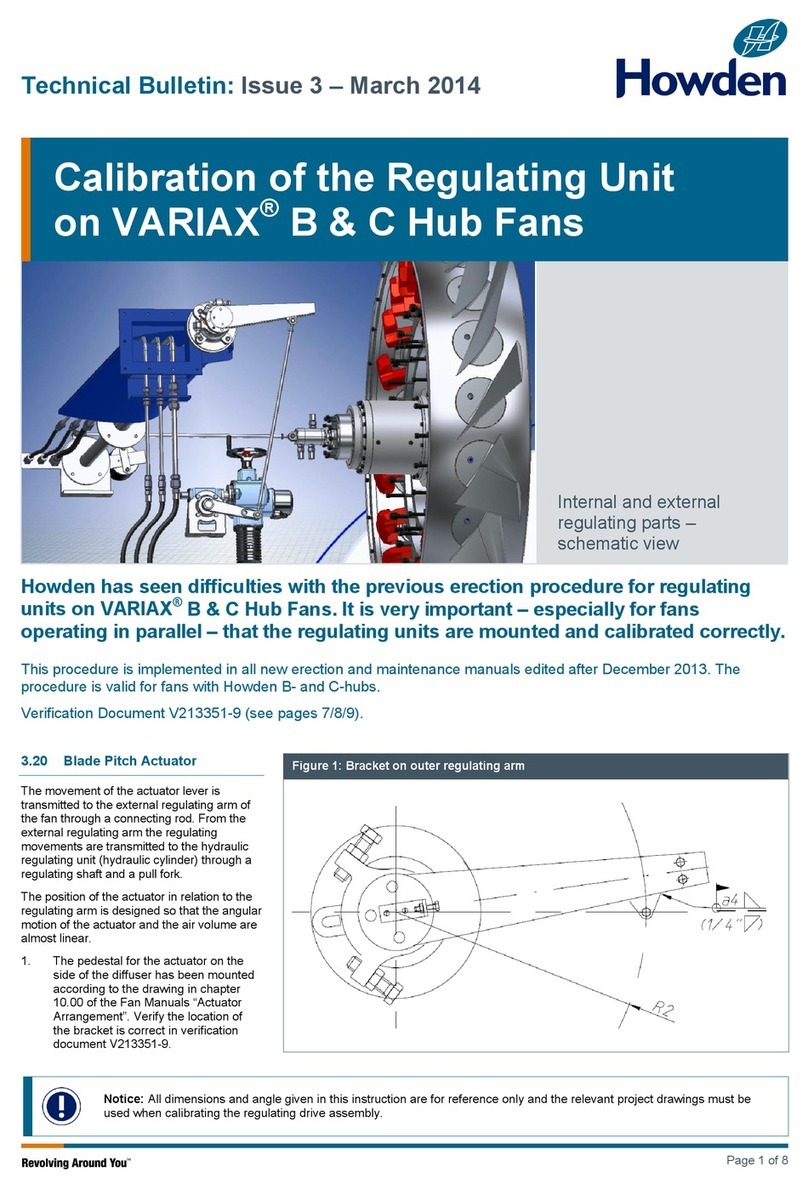
Howden 24-07.030r043/25
E-series Axial Flow Cooling Fans
I. GENERAL INFORMATION
Introduction
This manual provides information necessary to
install, operate and maintain E-series axial
flow cooling fans. Maintenance guidelines and
procedures are given so that your equipment
will operate efficiently, with a minimum of re-
pair or replacement requirements.
Description
Howden E-series fans are most widely used
and are available in three different blade pro-
files, ENF, ELF & ELFA. Whether you are
looking for a highly efficient impeller and/or a
low noise solution, the E-series offers you a
choice. The fibreglass reinforced polyester
blades have an integral shaft, which eliminates
concentration of stress at mechanical joints.
The FRP blade material offers superior damp-
ing of mechanical vibrations and of structure
borne noise compared with metal blades, pro-
longing the fan‟s lifetime. The fan blades are
connected to a polyurethane coated steel hub
with aluminium clamping pieces and A2
stainless steel or ST8.8 galvanised steel U-
bolts, nuts and washers for an easy installation
and manual blade pitch variation. The
impellers are connected to the drive shaft by
means of a polyurethane coated cast iron cou-
pling flange, with a cylindrical bore and electro-
galvanised hardware.
Howden E-series impellers are in compliance
with EC directive 94/9EC (ATEX 100) for the
equipment of level group II, Category 2, poten-
tially explosive environment class 01. Also re-
spect the instructions in paragraph IV commis-
sioning.
Note: The nomenclature is ‘cooling fans’,
however Howden supplies impellers only. Im-
pellers are components in the sense of Euro-
pean Machinery Directive 98/37/EC.
Allowable operating temperature
Allowable incidental upset temp. (<12 h)
Maximum tip speed
(As well depends on duty point)
Table 1: Description table E-series
Options / Accessories (at extra cost)
Coupling flange with tapered bushing
connection, instead of standard cylindrical
bore connection.
Epoxy coating.
A4 stainless steel hardware.
Baked epoxy coating on aluminium
clamping pieces.
Polyurethane leading edge protection for
wet applications or stainless steel leading
edge protection for severe erosion.
Retaining plates to secure the impeller to
the drive shaft.
Bolted clamping piece fastening instead
of location pins, for horizontal drive shaft
applications.
Special impellers for fan selections out-
side the standard design range.
Tools (torque wrench or an inclinometer
for blade pitch adjustment).
Field Service
Howden Service maintains a staff of experi-
enced field service personnel. Their expert
knowledge may be of great assistance at in-
spection, installation, or to get your fan unit
back in service with a minimum of delay.




























